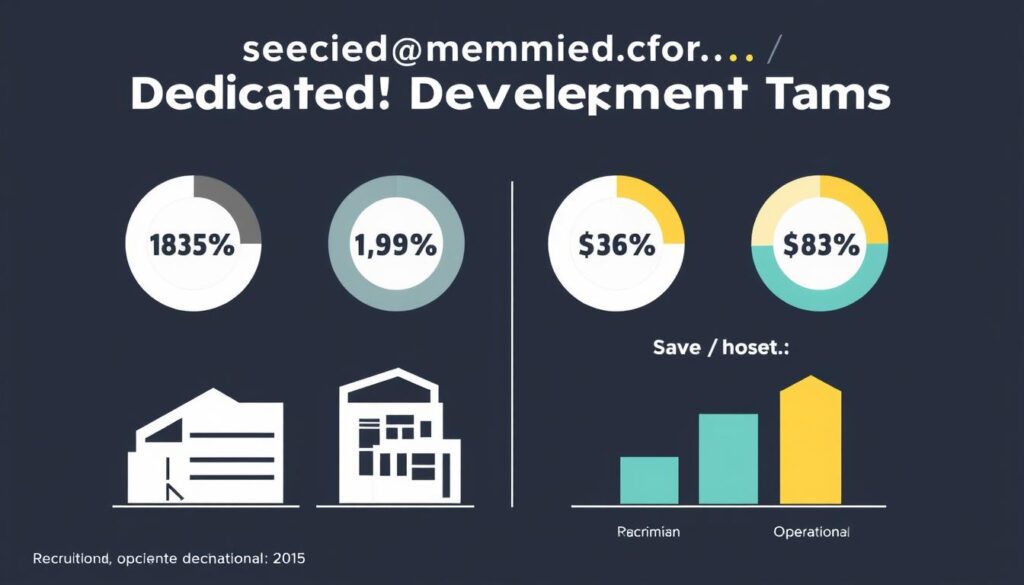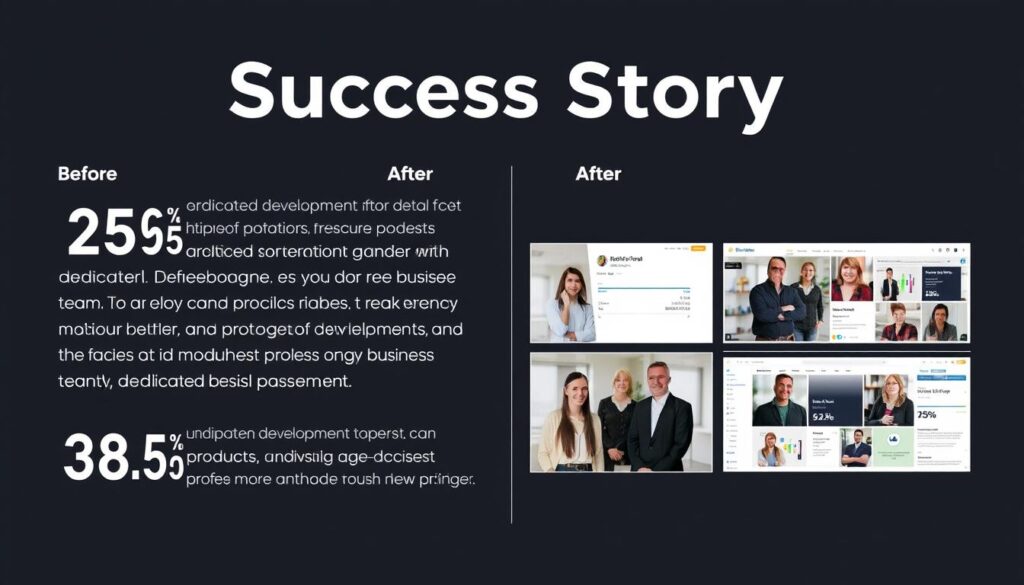Table of Contents
What is a Dedicated Development Team?
Dedicated teams work exclusively on your project while being managed by a third-party provider
A dedicated development team is a partnership model where a group of software professionals works exclusively on your project while being employed by a third-party provider. Unlike traditional outsourcing where developers might juggle multiple clients, dedicated teams function as an extension of your in-house team, focusing solely on your product development needs.
This model differs significantly from working with freelancers or building an in-house team. With freelancers, you typically get individual contributors working on specific tasks without deep integration into your processes. In-house teams, while fully under your control, come with significant overhead costs and recruitment challenges.
The dedicated team model offers a middle ground – developers who work exclusively for you but without the administrative burden of direct employment. Your dedicated team provider handles recruitment, office space, equipment, payroll, and other operational aspects, allowing you to focus on product development and business goals.
Core Characteristics of Dedicated Development Teams
- Exclusive focus on your project (no task-switching between different clients)
- Direct communication and management by your company
- Long-term collaboration (typically months or years)
- Flexible scaling based on project needs
- Integration with your development processes and tools
- Operational management handled by the service provider
Key Benefits of Working with a Dedicated Development Team

The dedicated team model has gained popularity for good reasons. Here are the primary advantages you can expect when working with a dedicated development team:
Cost Efficiency Without Compromising Quality
One of the most compelling reasons companies choose dedicated teams is cost optimization. By partnering with providers in regions with lower operating costs, you can access top talent at rates 40-60% lower than in major tech hubs like Silicon Valley or London. Beyond salary savings, you eliminate expenses related to recruitment, office space, equipment, benefits, and HR administration.
These savings don’t come at the expense of quality. Many offshore and nearshore regions have excellent technical education systems and experienced developers who have worked on global projects. Your provider handles quality assurance by vetting candidates and ensuring they meet your specific requirements.
Access to Global Talent and Specialized Expertise
The global talent shortage in technology is real. According to recent studies, there are over 1 million unfilled tech positions in the US alone. A dedicated development team gives you access to a global talent pool, allowing you to find specialists with the exact skills you need, regardless of your local market limitations.
This is particularly valuable when you need expertise in emerging technologies or niche skills that are scarce locally. Whether you need AI/ML specialists, blockchain developers, or experts in specific frameworks, the global talent market offers more options than any single location.
Scalability and Flexibility
Business needs change, and your development resources should be able to adapt accordingly. With a dedicated team, you can scale up or down based on project requirements without the lengthy processes of hiring or the difficult decisions around layoffs.
Need to add three more developers to meet a deadline? Your provider can typically source qualified candidates within weeks. Project scope reduced? You can adjust your team size without severance packages or legal complications. This flexibility is invaluable for businesses with fluctuating development needs or those in growth phases.
Focus on Core Business Goals
Managing a development team involves significant administrative overhead. By delegating this to a dedicated team provider, your internal leadership can focus on strategic initiatives rather than day-to-day team management.
Your provider handles recruitment, retention, workspace, equipment, and administrative tasks, freeing your time for product strategy, market positioning, and business development. This division of responsibilities allows each party to focus on what they do best.
Ready to explore how a dedicated team can accelerate your development?
Our experts can help you assess your needs and build a custom team tailored to your project requirements.
Structure and Roles in a Dedicated Development Team

Understanding the typical structure of a dedicated development team helps set clear expectations for collaboration. While team composition varies based on project needs, most dedicated teams include these key roles:
Project Manager
The project manager serves as the primary point of contact between your company and the development team. They coordinate daily operations, ensure deadlines are met, manage resources, and facilitate communication. A good project manager bridges cultural and organizational gaps, making remote collaboration seamless.
- Coordinates team activities and resources
- Tracks progress against milestones
- Identifies and mitigates risks
- Facilitates communication between stakeholders
Software Developers
Developers form the core of your dedicated team. Depending on your project needs, this may include frontend developers, backend developers, full-stack engineers, mobile developers, or specialists in specific technologies. These professionals write, test, and maintain the code that powers your application.
- Implement features based on requirements
- Write clean, maintainable code
- Participate in code reviews
- Troubleshoot and resolve technical issues
QA Engineers
Quality Assurance engineers ensure your software meets quality standards and functions as expected. They develop and execute test plans, identify bugs, and verify fixes. QA engineers play a crucial role in maintaining product quality and preventing issues from reaching end users.
- Create and execute test cases
- Perform manual and automated testing
- Report and track defects
- Validate fixes and improvements
UI/UX Designers
Designers create the visual elements and user experience of your application. They develop wireframes, prototypes, and final designs that ensure your product is not only functional but also intuitive and appealing to users. Good designers balance aesthetics with usability to create compelling user experiences.
- Create user-centered designs and interfaces
- Develop wireframes and prototypes
- Conduct usability testing
- Collaborate with developers on implementation
Business Analysts
Business analysts bridge the gap between business requirements and technical implementation. They gather and document requirements, create user stories, and ensure the development team understands the business context of features they’re building. This role is especially important for complex projects with evolving requirements.
- Gather and document requirements
- Create detailed specifications
- Prioritize features based on business value
- Validate that implementations meet requirements
DevOps Engineers
DevOps engineers manage the infrastructure and deployment processes for your application. They set up continuous integration/continuous deployment (CI/CD) pipelines, manage cloud resources, and ensure your application is secure, scalable, and reliable. This role is increasingly important as applications grow more complex.
- Set up and maintain development infrastructure
- Automate build and deployment processes
- Monitor system performance
- Implement security best practices
Workflow and Methodologies
Most dedicated development teams follow Agile methodologies, particularly Scrum or Kanban. These approaches emphasize iterative development, regular feedback, and adaptability to changing requirements. A typical workflow includes:

- Sprint Planning: The team plans work for the upcoming sprint (typically 1-2 weeks), selecting tasks from the prioritized backlog.
- Daily Standups: Brief daily meetings where team members share progress, plans, and blockers.
- Development and Testing: The team implements features and conducts testing throughout the sprint.
- Sprint Review: At the end of each sprint, the team demonstrates completed work to stakeholders for feedback.
- Retrospective: The team reflects on the sprint, identifying improvements for future work.
This structured approach ensures transparency, regular delivery of value, and continuous improvement. Your dedicated team provider should be able to adapt their processes to align with your preferred methodology or existing workflows.
Common Challenges When Working with a Dedicated Development Team

While dedicated development teams offer numerous benefits, they also come with challenges that should be addressed proactively. Understanding these potential hurdles helps you prepare strategies to overcome them:
Communication and Time Zone Differences
One of the most significant challenges in working with offshore dedicated teams is managing communication across different time zones. When your team is several hours ahead or behind your local time, coordinating meetings and getting timely responses can be difficult.
Solutions:
- Establish overlapping work hours for real-time collaboration
- Use asynchronous communication tools (Slack, email, project management software)
- Document decisions and requirements thoroughly
- Schedule regular video calls during overlapping hours
- Consider nearshore options if time zone alignment is critical
Cultural and Language Barriers
Cultural differences can affect communication styles, work expectations, and problem-solving approaches. Language barriers may lead to misunderstandings or hesitation in raising questions or concerns.
Solutions:
- Invest time in cultural awareness training for both teams
- Establish clear communication protocols and expectations
- Encourage open dialogue and questions
- Use visual aids and written documentation to supplement verbal communication
- Choose providers with strong English proficiency and cultural compatibility
Integration with In-house Teams
When dedicated teams work alongside in-house developers, integration challenges can arise. Different processes, tools, or even subtle competition between teams can impact collaboration and productivity.

Solutions:
- Treat dedicated team members as part of your company, not as outsiders
- Include them in company communications, meetings, and events when possible
- Standardize tools and processes across all teams
- Facilitate relationship-building through team-building activities
- Assign integration champions from both teams to facilitate collaboration
Quality Control and Oversight
Maintaining consistent quality standards can be challenging when your development team is remote. Without proper oversight, code quality, testing coverage, or documentation may suffer.
Solutions:
- Establish clear quality standards and expectations
- Implement automated testing and continuous integration
- Conduct regular code reviews
- Use monitoring tools to track performance metrics
- Schedule regular quality audits and retrospectives
Facing challenges with your current development approach?
Our dedicated teams are built to overcome common outsourcing challenges through better communication, cultural alignment, and quality processes.
Best Practices for Working with a Dedicated Development Team

Success with a dedicated development team doesn’t happen by accident. These best practices will help you establish a productive and effective partnership:
Thorough Onboarding Process
A comprehensive onboarding process sets the foundation for successful collaboration. Take time to introduce your dedicated team to your company, product, and existing codebase.
- Share company background, vision, and values
- Provide detailed product documentation and roadmaps
- Conduct technical knowledge transfer sessions
- Set up access to necessary tools and repositories
- Introduce team members to key stakeholders
Clear Communication Channels and Expectations
Establishing structured communication protocols prevents misunderstandings and ensures everyone stays aligned.
- Define primary and backup communication channels
- Establish regular meeting cadence (daily standups, sprint planning, etc.)
- Document decisions and action items
- Set response time expectations for different communication types
- Create escalation paths for urgent issues
Shared Tools and Processes
Using the same tools across all teams creates consistency and transparency in your development process.

- Project management tools (Jira, Asana, Trello)
- Communication platforms (Slack, Microsoft Teams)
- Code repositories and version control (GitHub, GitLab)
- Documentation systems (Confluence, Notion)
- Continuous integration/continuous deployment pipelines
Regular Face-to-Face Interaction
While most collaboration happens remotely, periodic in-person meetings strengthen relationships and alignment.
- Schedule quarterly or bi-annual visits when possible
- Bring key team members onsite for critical project phases
- Conduct virtual team-building activities between visits
- Use video calls instead of audio-only for regular meetings
Knowledge Sharing and Skill Development
Investing in your dedicated team’s growth benefits both their professional development and your project quality.
- Encourage participation in relevant training and conferences
- Organize knowledge-sharing sessions between teams
- Provide access to learning resources and platforms
- Recognize and reward skill advancement
Regular Performance Reviews and Feedback
Continuous improvement requires regular assessment and constructive feedback.
- Conduct regular performance reviews with individual team members
- Provide specific, actionable feedback
- Celebrate successes and achievements
- Address issues promptly and constructively
- Solicit feedback from the team about your processes and communication
Real-World Examples: Dedicated Development Teams in Action

To illustrate how dedicated development teams work in practice, let’s examine some real-world examples of companies that have successfully leveraged this model:
Startup Accelerating Time-to-Market
A fintech startup needed to launch their MVP quickly but struggled to find affordable local talent with the necessary expertise in payment processing systems.
Solution:
They partnered with a dedicated team provider to build a 7-person team including backend developers, frontend specialists, and a QA engineer with fintech experience.
Results:
- Reduced time-to-market by 40%
- Saved approximately $300,000 in first-year development costs
- Successfully secured Series A funding based on the MVP
- Scaled the team to 15 members as the product grew
Enterprise Addressing Talent Shortage
A healthcare software company faced challenges finding specialized developers with HIPAA compliance knowledge and experience with their legacy systems.
Solution:
They established a dedicated development center with 20+ specialists who worked alongside their in-house team, focusing on modernizing their platform while maintaining compliance requirements.
Results:
- Successfully modernized their platform within 18 months
- Increased development velocity by 65%
- Maintained perfect compliance record
- Reduced operational costs by 35%
Mid-Size Company Scaling Development
An e-commerce platform needed to rapidly expand their development capacity to implement new features and integrations demanded by their growing customer base.
Solution:
They built a dedicated team of 12 developers, designers, and QA specialists who took ownership of specific product modules while integrating with their existing development processes.
Results:
- Doubled feature delivery rate within 6 months
- Improved product quality with comprehensive QA processes
- Expanded to new markets with localized features
- Achieved 99.9% uptime during peak shopping seasons
Key Success Factors from These Examples
Analyzing these success stories reveals common factors that contributed to positive outcomes:
- Clear objectives and expectations from the beginning of the partnership
- Thorough vetting of team members for both technical skills and cultural fit
- Seamless integration with existing teams and processes
- Regular communication and transparency between all stakeholders
- Flexibility to adapt team size and composition as project needs evolved
- Investment in relationship-building beyond just technical collaboration
These examples demonstrate that with the right approach, dedicated development teams can deliver significant value across different company sizes and industries. The key is finding a provider who understands your specific needs and can build a team that aligns with your technical requirements and company culture.
Ready to build your own success story?
Our dedicated development teams have helped companies across industries accelerate their growth and innovation.
How to Choose the Right Dedicated Development Team Provider

Selecting the right partner for your dedicated development team is crucial for success. Here’s a systematic approach to evaluating potential providers:
Define Your Requirements Clearly
Before approaching providers, document your specific needs:
- Technical skills and expertise required
- Team size and composition
- Project timeline and milestones
- Budget constraints
- Communication and reporting expectations
- Security and compliance requirements
Evaluate Technical Expertise and Industry Experience
Look for providers with relevant experience in your industry and technology stack:
- Review their portfolio and case studies
- Ask for references from similar projects
- Assess their technical blog posts and contributions
- Evaluate their understanding of your industry challenges
Assess Communication and Cultural Compatibility
Effective collaboration requires good communication and cultural alignment:

- Evaluate English proficiency and communication skills
- Assess time zone compatibility
- Consider cultural factors that might impact collaboration
- Review their communication tools and processes
Examine Their Recruitment and Retention Practices
The quality of your team depends on how the provider recruits and retains talent:
- Understand their hiring process and standards
- Ask about employee turnover rates
- Inquire about professional development opportunities
- Review their workplace culture and benefits
Verify Security and Intellectual Property Protection
Protecting your data and intellectual property is essential:
- Review their security policies and certifications
- Understand their approach to confidentiality
- Clarify intellectual property ownership
- Assess their compliance with relevant regulations
Consider Scalability and Flexibility
Your needs may change over time, so choose a provider who can adapt:
- Assess their ability to scale your team quickly
- Understand their policies for team changes
- Evaluate their capacity for long-term partnership
- Review contract terms for flexibility
Compare Pricing Models and Total Cost
Understand the full cost implications beyond hourly rates:
- Compare transparent pricing structures
- Identify any hidden costs or fees
- Understand payment terms and billing cycles
- Evaluate the overall value proposition
| Evaluation Criteria | Questions to Ask | Red Flags |
| Technical Expertise | Can you provide examples of similar projects? What is your experience with [specific technology]? | Vague answers, inability to provide relevant examples |
| Communication | How will we communicate daily? What tools do you use? How do you handle time zone differences? | Poor response times, language barriers during initial discussions |
| Team Selection | How do you select team members? Can we interview candidates? What happens if someone isn’t a good fit? | No client involvement in selection, unwillingness to replace team members |
| Security | What security measures do you have in place? How do you handle confidential information? | Lack of security policies, no certifications, vague answers about data protection |
| Pricing | What is included in your rates? Are there any additional costs? What happens if we need to scale up/down? | Unclear pricing structure, unusually low rates, significant hidden costs |
Getting Started with Your Dedicated Development Team

Once you’ve selected a provider, follow these steps to set up your dedicated development team for success:
- Define Project Scope and RequirementsCreate detailed documentation of your project scope, technical requirements, and expected outcomes. The more specific you are, the better your provider can match appropriate team members to your needs.
- Select Team MembersWork with your provider to select team members who match your technical and cultural requirements. Conduct interviews with potential team members to assess their skills, communication abilities, and cultural fit.
- Establish Communication ProtocolsSet up communication channels, meeting schedules, and reporting processes. Define how requirements will be shared, how progress will be tracked, and how issues will be escalated.
- Conduct Thorough OnboardingInvest time in properly onboarding your new team members. Share company background, product information, technical documentation, and access to necessary tools and systems.
- Start with a Pilot ProjectBegin with a smaller, well-defined project to allow the team to get familiar with your processes and expectations. This provides an opportunity to identify and address any issues before scaling up.
- Establish Regular Check-ins and ReviewsSchedule regular meetings to review progress, provide feedback, and address any concerns. This helps maintain alignment and allows for continuous improvement.
- Scale and Adjust as NeededAs your project progresses, work with your provider to adjust team size or composition based on changing requirements. The flexibility to scale is one of the key advantages of the dedicated team model.
Ready to build your dedicated development team?
Our experts will guide you through every step of the process, from team selection to successful project delivery.
Frequently Asked Questions About Dedicated Development Teams
How is a dedicated development team different from traditional outsourcing?
Unlike traditional outsourcing where a vendor takes complete ownership of a project, a dedicated development team works as an extension of your in-house team. You maintain direct management control, the team works exclusively on your project, and the collaboration is typically long-term. This model combines the cost benefits of outsourcing with the control and integration of an in-house team.
How do I manage a dedicated development team remotely?
Effective remote management of a dedicated team involves clear communication channels, regular video meetings, shared project management tools, and well-defined processes. Establish daily check-ins, use collaborative tools like Jira, Slack, and GitHub, and focus on results rather than monitoring hours. Building relationships and trust is also crucial for successful remote management.
What is the typical cost structure for a dedicated development team?
Most dedicated team providers charge a monthly fee per team member, which includes the developer’s salary plus the provider’s margin for recruitment, workspace, equipment, and administrative support. Rates vary based on location, experience level, and technical specialization. This model is typically more cost-effective than hiring in-house in high-cost locations, with savings of 40-60% compared to Silicon Valley or London rates.
How long does it take to set up a dedicated development team?
The timeline varies depending on team size and required skills, but typically ranges from 2-8 weeks. Finding specialists with niche skills may take longer, while more common roles can be filled more quickly. A good provider will be transparent about timelines and keep you updated throughout the recruitment process.
How do I ensure quality and security with a dedicated development team?
Quality and security require proactive measures: establish clear coding standards and review processes, implement automated testing and continuous integration, use secure development practices, sign comprehensive NDAs and contracts, conduct security training, and perform regular audits. Choose a provider with strong security credentials and a proven track record of quality delivery.
Conclusion: Is a Dedicated Development Team Right for You?
A dedicated development team can be a powerful solution for companies facing talent shortages, high local costs, or scaling challenges. This model offers the perfect balance between the control of in-house development and the cost-efficiency of outsourcing.
The success of your dedicated team depends on choosing the right partner, establishing effective communication processes, and investing in the relationship. When implemented correctly, this approach can significantly accelerate your development capabilities while optimizing costs.
Consider a dedicated development team if you:
- Need to scale your development capacity quickly
- Struggle to find specialized talent locally
- Want to reduce development costs without sacrificing quality
- Have long-term development needs rather than short-term projects
- Prefer direct management control over your development resources
By understanding what to expect when working with a dedicated development team and following the best practices outlined in this guide, you can set your partnership up for success and achieve your development goals more efficiently.
Take the next step in your development journey
Contact us today to discuss how a dedicated development team can help you achieve your business objectives.










